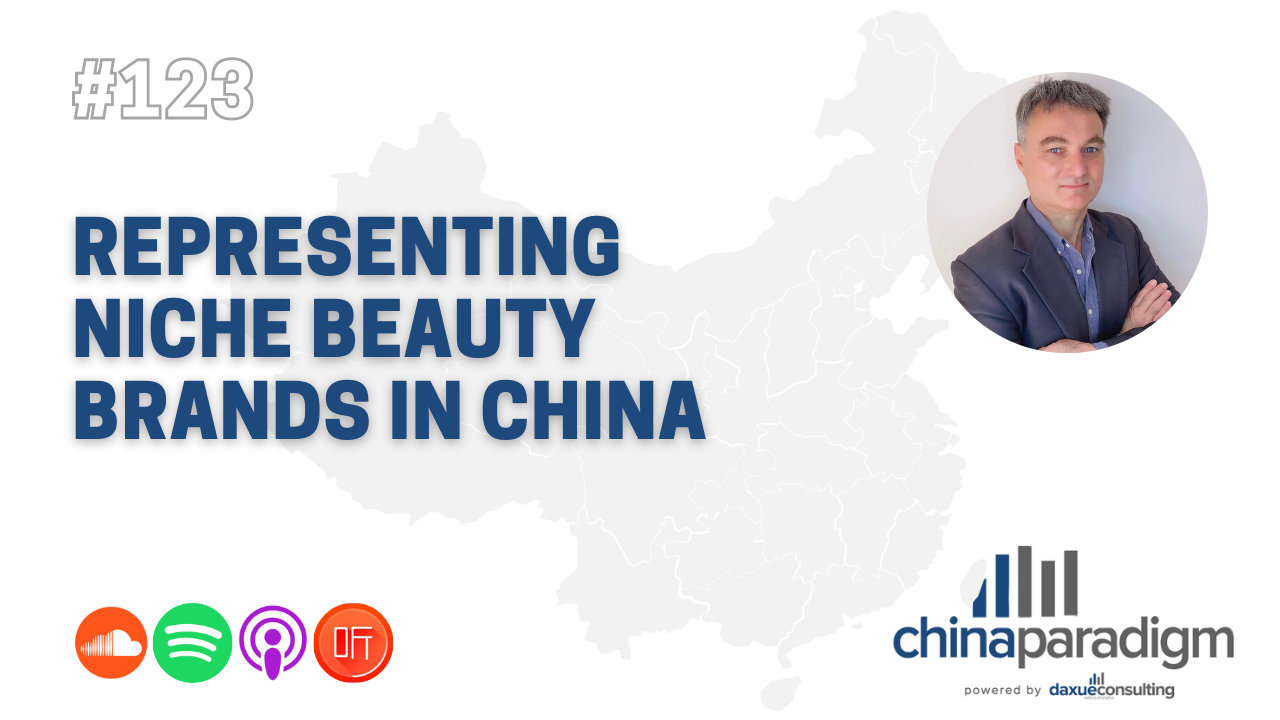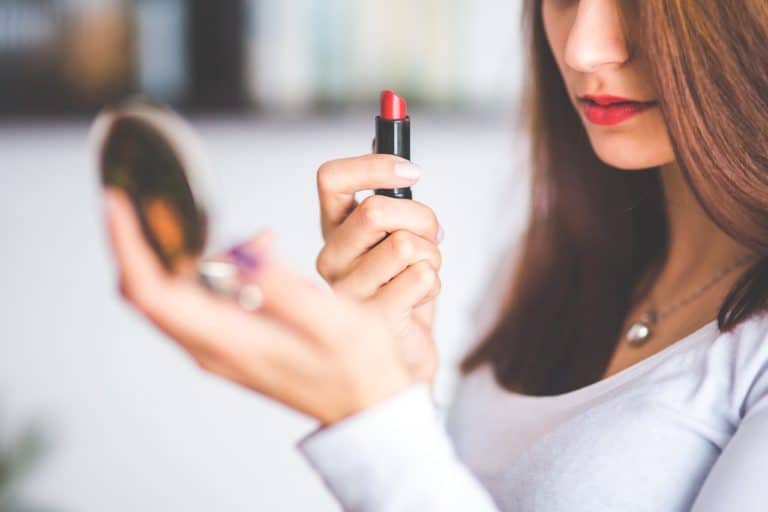GED localizes and establishes foreign cosmetics and skincare brands in China. Currently, GED is partnering with about 20 cosmetics brands. Having initially started with offline channels and distribution with SEPHORA, they are now focusing on digital online sales and marketing channels such as RED, WeChat, Weibo, Bilibili, TikTok, Tmall, JD, VIPshop, and others. Their target markets are Gen Z and millennial cosmetics consumers in China.
They focus on four main segments; make-up, perfume, skincare, and beauty products. They have accumulated 17 years of experience in the China market. In his opinion, the less well a brand is faring domestically, the more willing they are to try and break into the Chinese market. Also, he feels that not being in China, and not being online in China is a recipe for failure. 11.11 and other e-commerce sales holidays can be a massive component of a brand’s annual sales but he advises the brands he partners with not to compete on price, rather to target a niche audience and compete on the uniqueness and attractiveness of the brand and its packaging.
Cross-border commerce didn’t exist in China 5 years ago but it is now a major channel for selling cosmetics and is a highly effective way to get your brand into China for a number of reasons. The unit value is quite high, you can make huge savings on customs, and the weight of the package can be quite low.
Listen to the full China Paradigm episode 123 on Youtube, Apple Podcast, Spotify, Soundcloud, or Ximalaya.
GED – company size and services
Jean-Philippe Benoist: We purchase about 20 million euros worth of products from small, niche brands every year. We are essentially distributors, we buy products from the West and then we sell them here in China. Usually when a brand starts to do very well, they will either be bought by larger brands or come and set up an official presence in China. Before that stage, we purchase inventory and then manage the warehousing here in China. We make a mark-up on the product we sell.
What does the price point look like when GED buys products from brands they want to be in business with?
Jean-Philippe Benoist: Chinese consumers do not like it if the price of a brand is much lower in its domestic market than it is in China, prices should be roughly the same for foreign cosmetics and skincare brands in China as they are in Europe. We agree on a price with the brand but the price point has to be very similar here. Otherwise, the Chinese will ask a friend who lives in that country to send the product to them.
What is GED’s business model?
Jean-Philippe Benoist: We lookout for potential brands to add to our portfolio, then we will order a certain amount of inventory and then promote the foreign cosmetics and skincare brands in China and sell them online. If we take one example, the case of Glamglow, we brought them to a very high level in China and after two years they were purchased by Estee Lauder because they were ready to move to the next level.
It is unfortunate when we lose those successful brands but this is the business model we have, we never own the brand, and we are just third-party distributors. If the brands leave us, that means we have done a great job. We have the capability and expertise to do this better than the brands could probably manage to do it themselves. It’s a low-risk way for brands to enter China. Usually, it takes about 3 years to develop the brand.
Does GED tolerate Daigou trade?
Jean-Philippe Benoist: If they promote the foreign cosmetics and skincare brands in China, and sell the brand’s SKUs at the market rate or above the market rate, that is fine. However, if they start to compete with us on price, and sell below the market price, we will use our Tmall IP rights to have them removed from the platform.
What is typically the initial cost for GED to start distributing new foreign cosmetics and skincare brands in China? How high was the very first funding to start the company?
Jean-Philippe Benoist: Initially we borrowed money from family and friends, and the rest of the growth occurred organically. The initial cost will be higher to purchase inventory, but after one or two years, we can get better rates.
What would be the characteristics of brands that would have the potential to be big in China, in Jean-Philippe Benoist’s point of view?
Jean-Philippe Benoist: One condition is that the brand has to have a certain level of success in its own country before we will consider partnering with them. It must be of excellent quality. Also, it must be unique and has a good brand story.
What revenue should a brand earn on their original territory before considering selling products in China?
Jean-Philippe Benoist: Unless they have generated a minimum of 10 million euros, they should focus more on their own country. The more well-known in your own country, the more well-known you will be in China. But I would encourage brands not to waste time, China is going to be the number 1 market for brands in the world. If you create a digital footprint now, it will still be on RED, Weibo etc. in 10 years’ time.
The Quick Win Formula for successful branding in China
Jean-Philippe Benoist: Taobao first and foremost with your key product. Once you generate some traffic on Taobao, Tmall will allow you on their platform. Then you can look into going on RED, Kaola, and other platforms.
Using networks of KOLs to find out if the product could be a winner
Jean-Philippe Benoist: We will introduce the key product to our network of KOLs, and they will tell me whether the product is likely to succeed in China or not. If they like it they will then begin to promote it on the social media platforms.
How has the beauty market evolved in China from Jean-Philippe Benoist’s perspective?
Jean-Philippe Benoist: Skincare is the biggest category in China and people are will to spend really big on brands with efficacy. Tools are easily and quickly copied and that’s what we find when we bring a new one in. Fragrances are stable. Make-up is interesting because since the US created the industry, much of the production takes place in China so the Chinese market is well used to it but it is also a very expensive industry to get into because you need to be very creative and intelligent to keep up with the competition.
How does GED handle competition from already established brands when introducing a new brand of make-up in China?
Jean-Philippe Benoist: We are not trying to compete with Sephora or Watsons. We promote small, niche, innovative products with attractive designs. What’s more, we show how our product is unique but if we sell hundreds or thousands of units of that product every month, we would be happy. We are not looking to compete in the market for globally recognized brands that generate millions or billions of sales in China every year.
Which products from the make-up sector have the most momentum in China right now?
Jean-Philippe Benoist: Lip-balms are doing well, it’s the brand’s choice.
Why is festival promotion a phenomenon in China?
Jean-Philippe Benoist: The Internet is a bit of a killer when it comes to pricing because so many brands are competing on price on these e-commerce shopping holidays. However, we don’t compete on price. Many foreign cosmetics and skincare brands in China also want to maintain prices will offer free samples, we also don’t do that but to fight low prices, we will offer a small gift like buy one get one free or get some free samples but we maintain consistency in pricing. Our USP is not the price, it’s the product.
Is live streaming part of the market strategy for GED?
Jean-Philippe Benoist: No, it doesn’t really suit us. They are interested in selling discounted products in massive volumes in a short amount of time. And they also want to buy from us at a very low price. It’s not really pushing the product in the right way. Often brands can become dependent on these business models, once the vloggers stop vlogging the sales dry up.
1:07:56 What books have inspired Jean-Philippe Benoist the most in his entrepreneurial journey?
Jean-Philippe Benoist: The last business books I read were back when I was doing my MBA. Nowadays, I prefer to read books about physics and quantum technology. For business in China, I listen to people. I don’t speak Chinese so I like to ask for as many translations of what people are saying. In that way, I can really understand what people are saying. One book which was very interesting to me was called When China Awakes…The World Shall Tremble by Alain Peyrefitte.
What unexpected success and failure has Jean-Philippe Benoist witnessed in China?
Jean-Philippe Benoist: It’s very hard to be an expert on anything in China because the changes happen so fast. I know my own failures and successes. A recent success was their dealing with the coronavirus, there have been some failures, largely due to not being patient enough, and not listening enough. Peugeot failed. But the major success has been China itself.
Why does Jean-Philippe Benoist not have a LinkedIn page?
Jean-Philippe Benoist: I don’t want one, we only created the website because it was needed in the US. People come to us because of referrals and word of mouth. Our success has been based on our work. Brand.com is of no use in China anyway.
Listen to the full China Paradigm episode 123 on Youtube, Apple Podcast, Spotify, Soundcloud, or Ximalaya.





